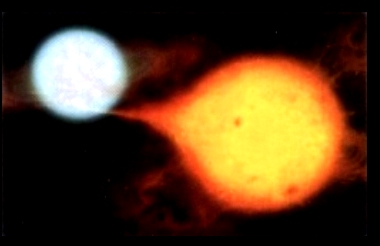|

Algol (Beta Persei), known colloquially as the Demon
Star, is a bright star in the constellation Perseus. It is one of the
best known eclipsing binaries, the first such star to be discovered,
and also one of the first (non-nova) variable stars to be discovered.
Algol is actually a three-star system (Beta Persei A, B and C) in which
the large and bright primary Beta Persei A is regularly eclipsed by the
dimmer Beta Persei B. Thus, Algol's magnitude is usually near-constant
at 2.1, but regularly dips to 3.4 every 2 days, 20 hours and 49 minutes
during the roughly 10-hour long partial eclipses. There is also a
secondary eclipse when the brighter star occults the fainter secondary.
In Star Trek. the Algolians are a humanoid species
native to the Alpha or Beta Quadrant. They are members of the United
Federation of Planets who sit on the Federation Archaeology Council and
attended the symposium on the USS Enterprise-D in 2367. (TNG: "Qpid").
An Algolian musician played music in the background at the biennial
Trade Agreements Conference held on Betazed in 2366. The song he played
was later used as a distress call when Commander Riker, Counselor Troi,
and Ambassador Troi were kidnapped by DaiMon Tog. (TNG: "Ménage
à Troi")
As an eclipsing binary, Algol in reality is two stars in
close orbit around one another. Because the orbital plane
coincidentally contains the Earth's line of sight, the dimmer star
(Algol B) passes in front of the brighter star (Algol A) once per
orbit, and the amount of light reaching Earth is temporarily decreased.
The larger of the two stars is losing material to its small companion,
the gas forming a tenuous disc around the smaller star.
To be more precise, however, Algol happens to be a
triple star system: the eclipsing binary pair is separated by only
0.062 AU, while the third star (Algol C) is at an average distance of
2.69 AU from the pair and the mutual orbital period is 681 days (1.86
years). The total mass of the system is about 5.8 solar masses. Algol
is 92.8 light years from Earth.
Studies of Algol led to the Algol paradox in the theory
of stellar evolution: although components of a binary star form at the
same time, and massive stars evolve much faster than the less massive
ones, it was observed that the more massive component Algol A is still
in the main sequence, while the less massive Algol B is a subgiant star
at a later evolutionary stage. The paradox can be solved by mass
transfer: when the more massive star became a subgiant, it filled its
Roche lobe, and most of the mass was transferred to the other star,
which is still in the main sequence. In some binaries similar to Algol,
a gas flow can be seen.
|
|
